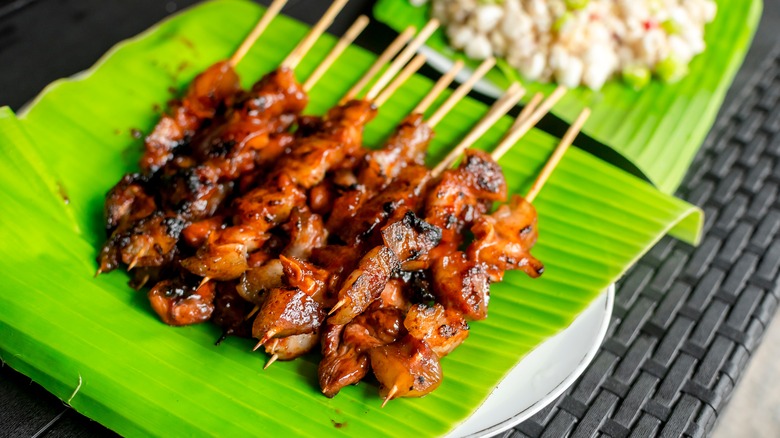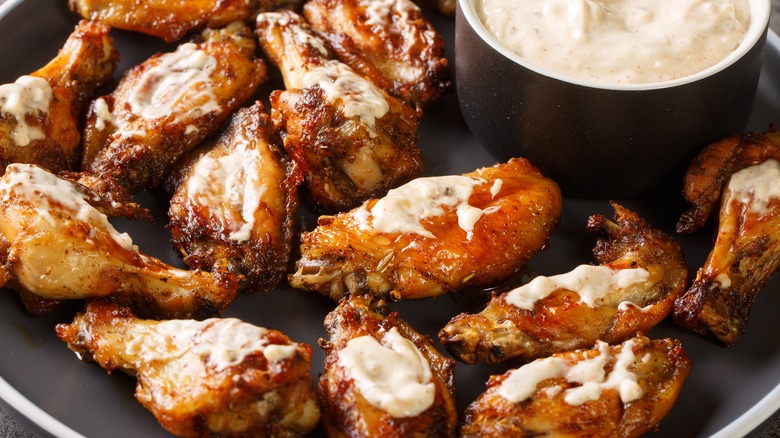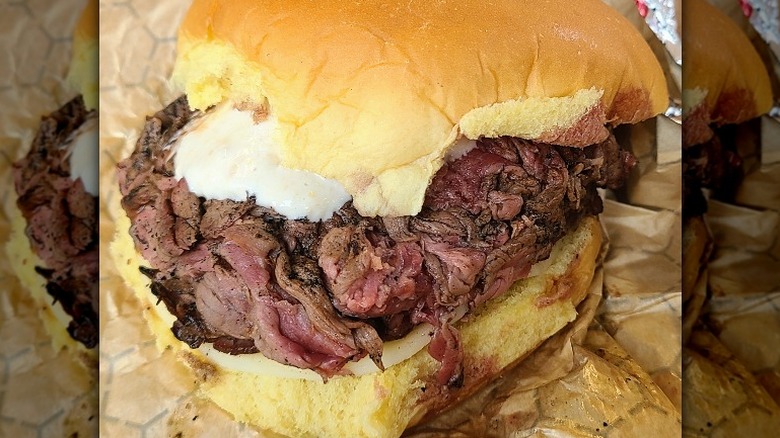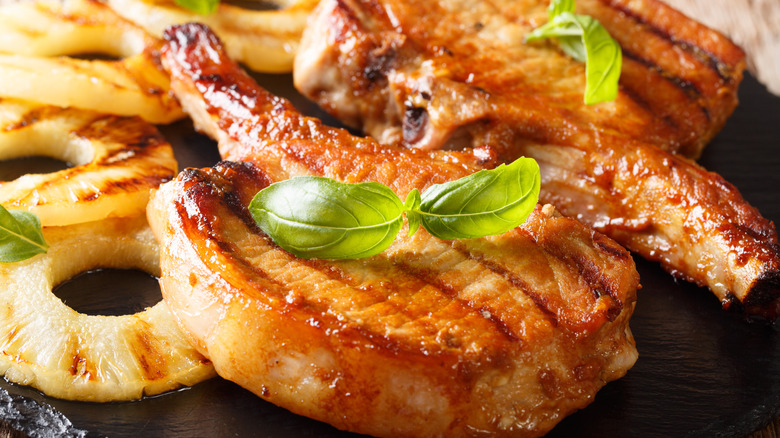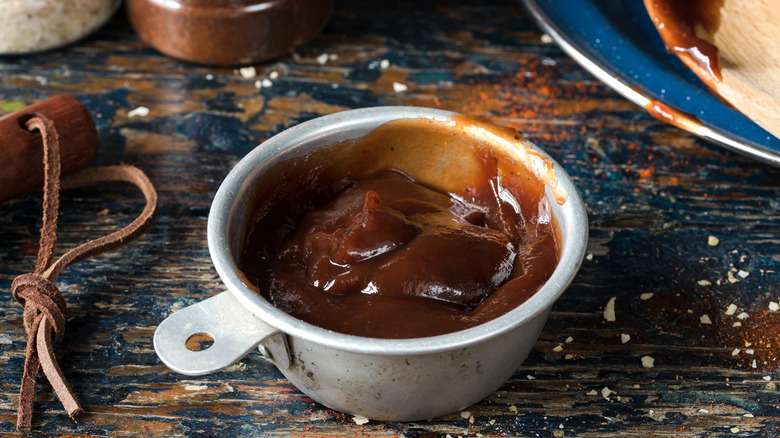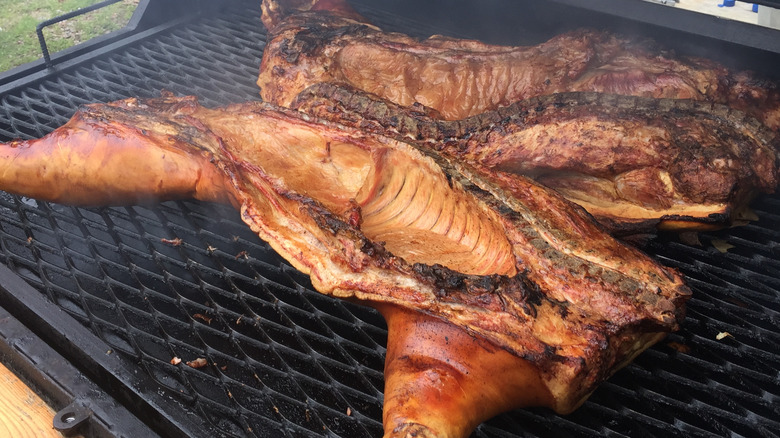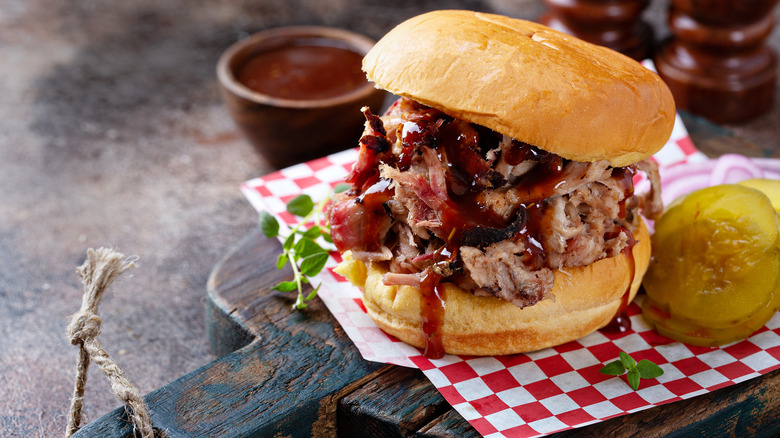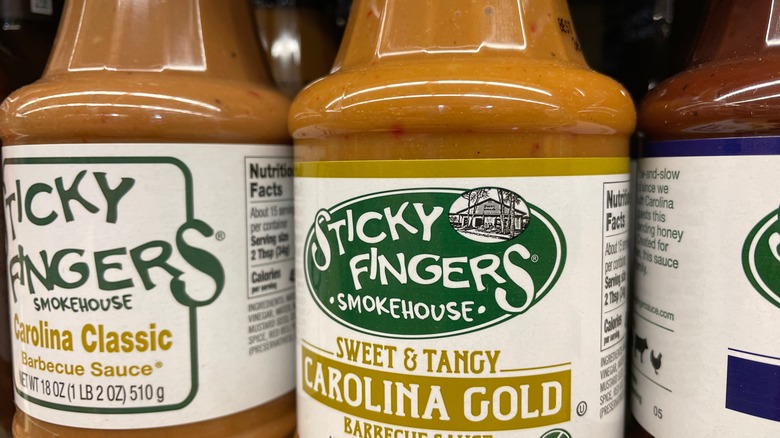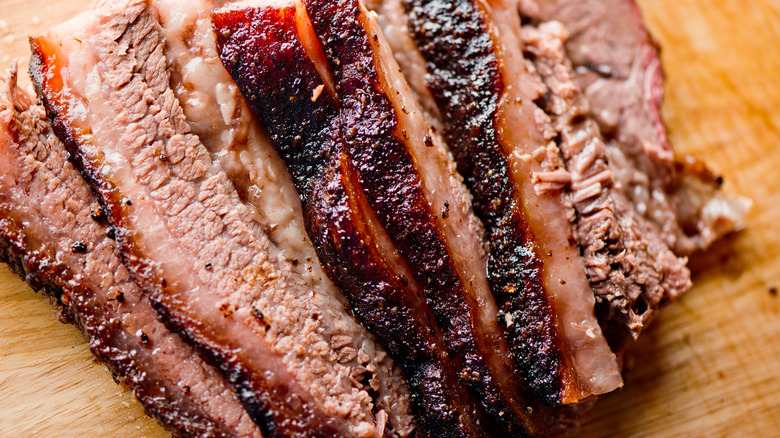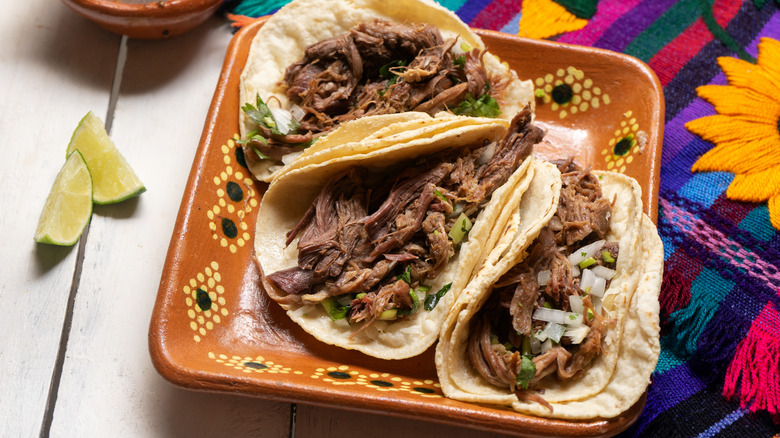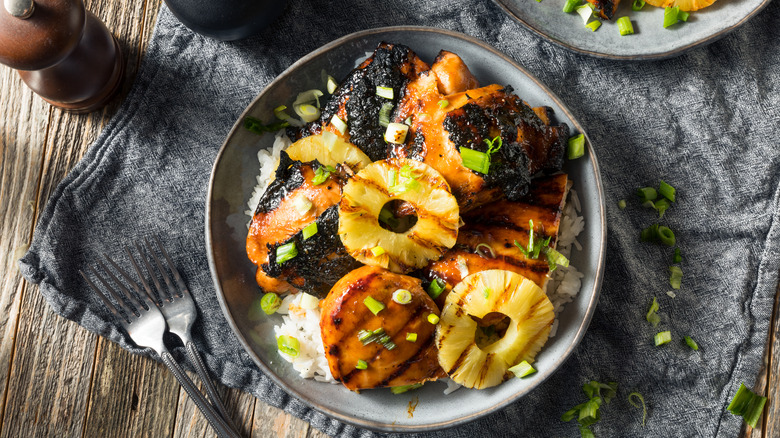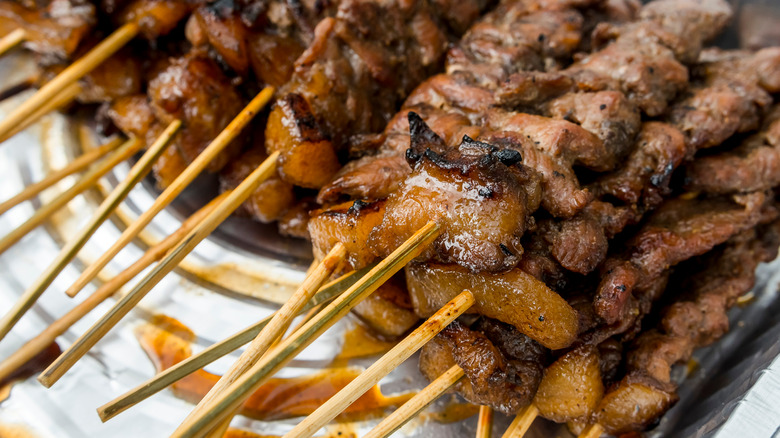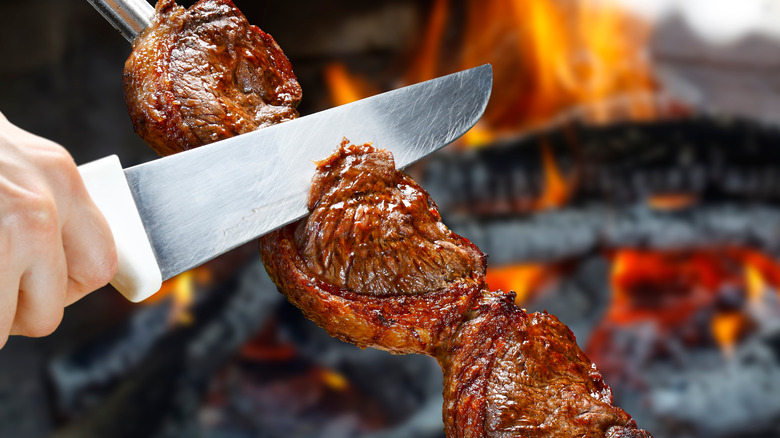12 Types Of Barbecue Sauce And When To Use Them
Like highway billboards, cans of light beer, or Justin Bieber songs, we often consume barbecue sauce without giving it a second thought. We slather it on racks of ribs. We pour it over pulled pork. In the frenzy of a late-night munchies attack, we dip chicken nuggets in it. You might have had a few middle-of-the-aisle dilemmas about which bottles of grocery store barbecue sauces to buy. But barbecue sauce should be much more than the same old, same old. For starters, there are many regional styles American of barbecue sauce to consider. In the Carolinas alone, there are three preeminent variations.
On top of that, there are many different styles of barbecue sauce worldwide. Using a barbecue sauce from the Philippines or Brazil can evoke the sense of a faraway place — which is something even the best-ranked flavor of Stubb's might struggle to do. Some of these sauces are meant for pork or beef, while others are made for chicken. Consider this short guide to different styles of barbecue sauce, and learn how you can best put them to use.
Alabama White Sauce
Alabama might be associated with the Crimson Tide, but the state's signature barbecue sauce is white as the driven snow. And this is what makes Alabama BBQ sauce so unique.
The creation of Alabama White Sauce is credited to "Big" Bob Gibson. While earning a living as a railroad worker during the 1920s in Decatur, Gibson would spend his weekends cooking barbecue for neighbors and friends. Gibson's barbecue became so popular that he eventually quit his railroad job and opened a restaurant. But perhaps Big Bob's signature most achievement is the creation of his white sauce: a combination of mayonnaise, vinegar, ground black pepper, and salt.
At Big Bob Gibson Bar-B-Que, white sauce gets used with a lot of menu items, but the restaurant says it's most commonly associated with grilled chicken. Pitmasters put whole chickens on the barbecue pit, roast them, and then "baptize" them in the signature white sauce. The chicken is then served by the quarter, by the half, or on a sandwich. The white sauce is also available at thousands of retail locations across multiple states.
Baltimore Tiger Sauce
While the origins of some regional American barbecue styles can be traced back hundreds, or even thousands of years, pit beef — Baltimore's contribution to the BBQ canon — was only developed about five decades ago. A seminal component of this regional barbecue is tiger sauce, a horseradish-based white sauce.
Pit beef is made with the bottom round cut of beef. At the iconic Chaps Pit Beef, the bottom round is roasted over hardwood charcoal at between 400 and 500 degrees Fahrenheit to create a charred exterior and rare interior. The meat is then sliced thin with a deli slicer. Slices are cooked to order and piled high on a Kaiser roll.
But the coup de grâce is the topping of onions and tiger sauce. According to a recipe from Sheffield Spices and Tea Company, tiger sauce includes horseradish, mayonnaise, lemon juice, garlic, cayenne, salt, and pepper.
Florida-Style Barbecue Sauce
To be fair, Florida is probably best known for things like oranges and Disney World. The Sunshine State isn't exactly a barbecue Mecca, but that doesn't mean you should sleep on what makes Florida BBQ sauce so unique.
The state's location between the Deep South and the Caribbean can be seen and tasted in many Florida foods. When it comes to Florida's barbecue sauce, Cuba and the Carolinas hold significant sway, but influences from Portugal, Spain, and each nation's former colonies — such as Brazil — can be tasted in the food (via Porcao Grill). On one hand, Florida barbecue sauce incorporates a significant amount of vinegar and sugar. On the other hand, the sauce is influenced by a Cuban sauce called mojo de ajo. The latter sauce includes citrus juice, cumin, oregano, cilantro, garlic, salt, and pepper (via New York Times Cooking).
As a fairly light and acidic sauce, Florida-style barbecue sauce pairs well with meat or seafood. In fact, the sauce is an ideal pairing with the iconic Florida seafood dish known as smoked mullet. Additionally, as Portuguese churrasco often uses these sorts of seasonings and juices as a marinade, using Florida-style barbecue sauce to soak meats is a unique way of sprucing up an ordinary food.
Kansas City Barbecue Sauce
If there's an American barbecue sauce that we've all tried at some point in our lives, it's probably Kansas City-style barbecue sauce. It is one of the more popular dipping sauces, used on everything from pork ribs to McNuggets.
This sauce is what makes Kansas City barbecue so unique and comes out of a storied tradition. Historians largely credit the Kansas City-style of barbecue to Henry Perry. After moving from Reconstruction-era Memphis to Kansas City, Perry set up a barbecue street cart in the city's Garment District. The barbecue cart was so successful that Perry ended up opening three brick-and-mortar restaurants before dying in the late 1930s. This local chain of barbecue giants also spun off two now-iconic Kansas City barbeque institutions: Arthur Bryant's and Gates Barbecue.
You probably know Kansas City-style barbecue like the back of your sauce-stained hand and don't need to be told that it is a tomato-based sauce that includes brown sugar vinegar and warming spices like paprika and cumin. Because the sauce contains a lot of sugar, it's not ideal for basting and is best used as a dipping sauce.
Eastern North Carolina Barbecue Sauce
These are troubling times. While politics is dividing our nation, North Carolina is being divided by something far more serious — barbecue. To understand the separation, it's good to know what makes east and west North Carolina BBQ sauce so different.
Influenced by its coastal location, Eastern North Carolina is part of the cradle of American barbecue known as the Low Country. Barbecue in this region is heavily focused on pork preparations, specifically whole hog barbecue. The fatty nature of pork lends itself to a more acidic sauce known as East Carolina barbecue sauce.
Whole hog barbecue involves cooking the entire animal over low and slow heat, usually overnight. As it cooks, the pig is basted with a signature barbecue sauce that includes very few ingredients: vinegar, crushed red pepper, sugar, salt, Tabasco, and ground black pepper (via New York Times Cooking). While this sauce isn't one of the more popular dipping sauces, it's a great basting sauce. When used on pork barbecue, it creates a smoky, tangy, and spicy meat.
Barbecue purists argue that this sauce allows the meat to shine and doesn't cover up bad techniques with excessive amounts of sugar and spice.
Western North Carolina Barbecue Sauce
Unlike those purists in Eastern North Carolina who embrace whole hog barbecue and a minimalist sauce, Western North Carolinians are not afraid to be more discerning with their cuts and insert a little ketchup into the mix.
Western North Carolina barbecue tends to focus more on the pork shoulder than the entire animal. This is because pork barbecue in the West tended to be sold in pop-up stands, as opposed to from large barbecue pits. Also, at one point in its history, Western North Carolina saw a massive wave of German immigrants, and historians have argued that these immigrants brought a taste for a tomato-based, sweet-and-sour Bavarian sauce.
The resulting West Carolina sauce is a milder sauce than its eastern cousin. Having a bit more sugar and body, it functions much better as a dipping sauce than sauces made mostly of vinegar. As it was developed for pork shoulder, this sauce goes great with the most popular dish to extend from this cut: pulled pork.
Carolina Gold Sauce
Made with mustard as its base, South Carolina barbecue sauce is steeped in a history that predates the Declaration of Independence. In the mid-18th century, the British colony of South Carolina actively recruited German immigrants for its agricultural industry. Eschewing the plantation farming that was common in the colony, German settlers established family farms along South Carolina's various rivers. They also brought with them a culinary tradition of using mustard (via the South Carolina Barbecue Association). Over the centuries, German families became deeply ingrained in South Carolina's barbecue culture, and their influence can be seen in the state's signature barbecue sauce.
The sauce known as Carolina Gold is somewhat controversial, but not entirely for the reason you might think. It was successfully marketed by and became associated with Maurice Bessinger, a 20th-century restauranteur who supported racial segregation (via Southern Kitchen). While Bessinger's grievous position is now thankfully behind us, South Carolina barbecue sauce enjoys robust support, especially from fans of mustard. It's commonly served with pulled pork, but it also makes a great sauce for chicken wings.
Central Texas Barbecue Sauce
Perhaps more than any other region in the United States, Texas is associated with beef barbecue and brisket in particular. Interestingly, the use of any sauce at all can be a point of contention in Texas. Texans take so much pride in using a dry rub, especially on brisket, that some will turn their noses up at even the suggestion of putting sauce on it. They may have to use sweet-and-sour sauces to cover up other types of barbecue, but Texas-style barbecue is good enough to stand on its own, as the logic goes. Texas may have a reputation for being anti-sauce, but the reality is — it's perfectly acceptable to put a slather of the good stuff on Texas barbecue.
In fact, Texas does have its own unique style of sauce. With the state's signature barbecue focusing so much on beef, it only makes sense that its signature beef-centric barbecue dressing prominently incorporates Worcester sauce. Some barbecue joints go further and incorporate drippings from the brisket into the sauce.
Texas Barbacoa Sauce
What makes Texas barbecue so unique is its diversity. In Southern and Southwest Texas, barbecue has started to take on more Mexican influences. This can be seen in the region's style of cooking, popular cuts of meat, and signature sauce.
Before Texas was incorporated into the United States, Mexican rancheros would barbecue an entire cow's head by wrapping it in leaves, placing it in a pit of coals, and covering it up with dirt to cook low and slow. Health department regulations have largely put the kibosh on this type of cooking, and pit barbecue has become the default style. However, tongue and other head cuts are still popular in this barbacoa-influenced style of Southern Texas cooking.
Instead of being Worcester-driven like the sauces of Central Texas, Texas barbacoa sauce incorporates molasses and liquid smoke. The result is a smoky-sweet marinade and basting sauce that locks in moisture (via Masterclass). This style of barbecue is also more commonly associated with tortillas, beans, salsa, and guacamole.
Huli Huli Sauce
Hawaii is known for its festive luau parties. If you really want to know what a Hawaiian luau is really like, go to Hawaii. If you want to save a few thousand dollars and just get a taste, you can make a signature luau barbecue dish called huli huli chicken.
Located at a sort of Pacific crossroads, Hawaii is home to a mix of people, particularly those with Polynesian, Japanese, Filipino and Chinese backgrounds. This melting pot of Pacific cultures translates into Hawaii having a natural sort of fusion as its signature cuisine. When it comes to barbecue chicken, it's only natural that the huli huli sauce used to make it would feature Pacific Island ingredients like pineapple, ginger, garlic, and soy sauce.
Huli huli chicken was created in 1955 by Honolulu businessman Ernest Morgado. The typical way of cooking the dish, per the New York Times, starts by marinating a whole chicken in huli huli sauce for at least eight hours. The chicken is then placed on a hot grill, covered, and allowed to cook for around 30 minutes. In Hawaiian, the word huli means turn, and every five minutes the chicken is turned on the grill to keep it from burning. With each turn, the chicken gets basted with more huli huli sauce. The chicken should be served once it is cooked through.
Filipino Pork Barbecue Sauce
When you think of making barbecue skewers from the Pacific, you might think of a yakitori Japanese grilling recipe or a recipe for chicken satay. Although they may be lesser known in the US, Filipino pork barbecue skewers are wildly popular and quite tasty.
Pork skewers and other barbecued street food are part and parcel of Filipino culture. In the capital of Manila, it's common to find everything from grilled intestines to grilled chicken feet (via BBC). The marinade and barbecue sauce typically used to flavor these foods were heavily influenced by American culture. From 1899 to 1946, the United States occupied the Philippines, and today, it's common for Filipinos to use American ingredients like Spam and 7-UP in their cooking. Filipinos even developed a variation on ketchup that uses bananas because tomatoes were hard to come by.
Filipino pork barbecue sauce incorporates two key products that came out of the American occupation: lemon-lime soda and banana ketchup. The sauce also typically contains soy sauce and calamansi, a citrus fruit that is native to the island nation (via Pilipinas Recipes).
Môlho de Churrasco
Referred to as churrasco, Brazilian barbecue has its origins in 18th-century cowboy culture. Cowboys — or gaúchos — would spend their days herding cattle. In the evenings, they would cook meats over large barbecue pits. Earlier approaches involved seasoning the meat with coarse salt and slowly roasting it over the pit. Over time, gaúchos started using more seasonings, and eventually, a unique sauce was developed called môlho de churrasco.
Unlike a lot of American barbecue styles that prioritize smoke, Brazilian barbecue is based on roasting large cuts of skewered meat over an open flame. As the meat is being roasted, it is commonly based with môlho de churrasco; a vinegar-based sauce that includes chilis, garlic, onion, parsley, rosemary, basil, thyme, and oregano (via Fiery Foods & Barbecue Central).
After the meat is cooked, it is removed from the skewers and served with a number of accouterments, including the salsa-like môlho campanha, a crunchy yuca flour called farofa, and a cheesy bread called pão de queijo (via Insider). While this barbecue has thick ties to South America, Eater reports that it has become common in the United States, and the style is evolving into something new. What American style will emerge from this fusion? Only time will tell.
